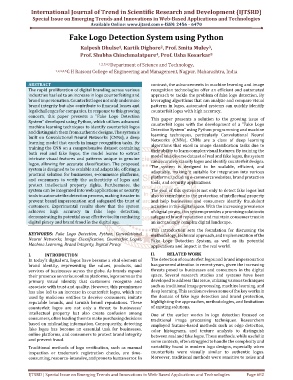Page 692 - Emerging Trends and Innovations in Web-Based Applications and Technologies
P. 692
International Journal of Trend in Scientific Research and Development (IJTSRD)
Special Issue on Emerging Trends and Innovations in Web-Based Applications and Technologies
Available Online: www.ijtsrd.com e-ISSN: 2456 – 6470
Fake Logo Detection System using Python
3
2
1
Kalpesh Dhulse , Kartik Dighore , Prof. Smita Muley ,
5
4
Prof. Shubha Chinchmalatpure , Prof. Usha Kosarkar
1,2,3,4,5 Department of Science and Technology,
1,2,3,4,5 G H Raisoni College of Engineering and Management, Nagpur, Maharashtra, India
ABSTRACT contrast, the advancements in machine learning and image
The rapid proliferation of digital branding across various recognition technologies offer an efficient and automated
industries has led to an increase in logo counterfeiting and approach to tackle the problem of fake logo detection. By
brand impersonation. Counterfeit logos not only undermine leveraging algorithms that can analyze and compare visual
brand integrity but also contribute to financial losses and patterns in logos, automated systems can quickly identify
legal challenges for companies. In response to this growing counterfeit logos with high accuracy.
concern, this paper presents a "Fake Logo Detection
This paper presents a solution to the growing issue of
System" developed using Python, which utilizes advanced
counterfeit logos with the development of a "Fake Logo
machine learning techniques to identify counterfeit logos
Detection System" using Python programming and machine
and distinguish them from authentic designs. The system is learning techniques, particularly Convolutional Neural
built on Convolutional Neural Networks (CNNs), a deep
Networks (CNNs). CNNs are a class of deep learning
learning model that excels in image recognition tasks. By
algorithms that excel in image classification tasks due to
training the CNN on a comprehensive dataset containing their ability to learn complex visual features. By training the
both real and fake logos, the model learns to extract model on a diverse dataset of real and fake logos, the system
intricate visual features and patterns unique to genuine can accurately classify logos and identify counterfeit designs.
logos, allowing for accurate classification. The proposed The system is designed to be scalable, efficient, and
system is designed to be scalable and adaptable, offering a adaptable, making it suitable for integration into various
practical solution for businesses, e-commerce platforms, platforms, including e-commerce websites, brand protection
and consumers to verify the authenticity of logos and tools, and security applications.
protect intellectual property rights. Furthermore, the
system can be integrated into web applications or security The goal of this system is not only to detect fake logos but
tools to automate the detection process, making it easier to also to contribute to the protection of intellectual property
prevent brand impersonation and safeguard the trust of and help businesses and consumers identify fraudulent
customers. Experimental results show that the system activities in the digital space. With the increasing prevalence
achieves high accuracy in fake logo detection, of digital piracy, this system provides a promising solution to
demonstrating its potential as an effective tool in combating safeguard brand reputation and maintain consumer trust in
digital piracy and brand fraud in the digital age. an increasingly complex digital landscape.
This introduction sets the foundation for discussing the
KEYWORDS: Fake Logo Detection, Python, Convolutional
methodology, technical approach, and implementation of the
Neural Networks, Image Classification, Counterfeit Logos,
Fake Logo Detection System, as well as its potential
Machine Learning, Brand Integrity, Digital Piracy
applications and impact in the real world.
I. INTRODUCTION II. RELATED WORK
In today’s digital era, logos have become a vital element of The detection of counterfeit logos and brand impersonation
brand identity, representing the values, products, and has garnered attention in recent years, given the increasing
services of businesses across the globe. As brands expand threats posed to businesses and consumers in the digital
their presence on various online platforms, logos serve as the space. Several research studies and systems have been
primary visual identity that customers recognize and developed to address this issue, utilizing various techniques
associate with trust and quality. However, this prominence such as traditional image processing, machine learning, and
has also led to an increase in counterfeit logos, which are deep learning. This section reviews some of the key works in
used by malicious entities to deceive consumers, imitate the domain of fake logo detection and brand protection,
reputable brands, and tarnish brand reputations. These highlighting the approaches, methodologies, and limitations
counterfeit logos are not only a threat to businesses' of existing solutions.
intellectual property but also create confusion among One of the earlier works in logo detection focused on
consumers, often leading them to make purchasing decisions traditional image processing techniques. Researchers
based on misleading information. Consequently, detecting employed feature-based methods such as edge detection,
fake logos has become an essential task for businesses, color histograms, and texture analysis to distinguish
online platforms, and consumers to protect brand integrity between real and fake logos. These methods, while useful in
and prevent fraud. some contexts, often struggled to handle the complexity and
Traditional methods of logo verification, such as manual variability found in modern logo designs, especially when
inspection or trademark registration checks, are time- counterfeits were visually similar to authentic logos.
consuming, resource-intensive, and prone to human error. In Moreover, traditional methods were sensitive to noise and
IJTSRD | Special Issue on Emerging Trends and Innovations in Web-Based Applications and Technologies Page 682

